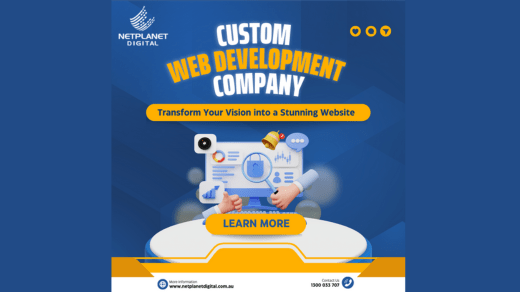As the world turns to the face of the internet through digital technologies, it is crucial for any business to have a good online image for it with the intention of surviving. One crucial aspect of such a presence is a website that works, that is functionally sound and accurately reflects the identity of your brand. Branding into your daily approach to custom web design helps to ensure that your site is memorable, as well as stimulating to the browser. In this article, you’ll find information on how branding may be included in the process of designing a website.
A custom website for business helps in creating a strong online presence that stands out from competitors.
To fully appreciate the value of incorporating branding elements in the design of websites, there are some key factors that one needs to consider.
Consistency Across Touchpoints
Brand identity is not just the company logo, a specific colour or even a consistent and continuous visual image but rather the perception held by the public about a firm. Maintaining a constant online presence helps people be familiar with the brand and the company and this is achieved with consistency in the branding. This is because a custom website which complements your brand ensures consistency in branding is achieved.
Building Trust and Recognition
Relevant branding of your website creates a good outlook in the eyes of your potential clients in the market. The specific message is that when a client comes to your site and notices a logical and well-coordinated design of the site and matching other branding materials, they are more likely to trust business. This trust translates into higher click-through rates on ads, longer stays on the site, and, as a consequence, higher conversion rates.
Establishing User Interfaces that Count
Your website is mostly the first contact prospective purchasers will have with your business. When you incorporate your branding elements into the design, customers are thus presented with an experience that is unique and can be easily remarked. Visual and auditory cues can work to your benefit when a company’s location stands out from the rest.
Branding in web design must meet for getting a successful result and has to pay attention to the following key elements.
1. Logo and Visual Identity
Logo Placement
As a general rule, your logo is placed on your website in the header section of the site. It should also point to the homepage of the site, so that users can easily find where they are and get back where they need to go. This is because logical, or clearly apparent, associations help maintain brand familiarity.
Colour Scheme
To reinforce your branding, always use your brand’s colour scheme on your website. This encompasses backgrounds, buttons, text and other items that make up the microscopic culture of the graphical user interface. Appropriate and consistent use of colour neither makes your site appear attractive but also ensure the site is consistent with the overall business brand.
2. Typography
Font Choices
Make sure to choose the right fonts, the ones that align with the brand personality you are looking to portray. You need your typography to clearly say ‘I belong to a playful brand’ or ‘I belong to a serious brand’, ‘I belong to a modern brand’ or ‘I belong to a traditional brand’. It is best advised to use no more than two or three fonts in the document to avoid an uncluttered and cluttered look.
Readability
Make sure that the fonts are readable irrespective of whether you are reading from a computer, your phone or tablet. This is particularly necessary for body text – the portions of a piece of writing that do not include headlines, subheadings, or boilerplate information. Typographic headlines and the call to action buttons themselves can call for more decorative fonts, although it has to be a brand language’s best practice.
3. Imagery and Graphics
Consistent Style
The clips and pictures put on your website should reflect your brand’s style. This covers the type of images (photographic, illustrations), the colour use, and artistic merit. This basic concept of limitation of points of view also helps in achieving a higher level of cohesion in terms of look and feel.
High-Quality Visuals
Although you need not always incorporate vivid colour, always use clarity or high resolution and graphics. Lack of quality visuals in the web design can be a great put off to the brand image as it spoils the professional outlook of the brand.
4. Voice and Tone
Content Style
The website content writing must be in the foundation of the brand’s personality and the conversationalist mode too. Regardless of the tone you want for your business: serious, casual, funny, or professional, stay loyal to it across the web pages.
Messaging
It will also ensure that the messages that are sent out are in harmony with the kind of brand image that you have and that they will appeal to your targeted consumers. Good and effective copy involves making the point and understanding the intended communications goals of the visitor.
5. User Experience (UX) Design
Intuitive Navigation
In essence, consumers should be able to easily and quickly surf within a website that has been well branded. Easy-to-navigate systems enable users to access the desired information with ease and in the process making it informative to use the system.
Interactive Elements
Also, ensure to integrate the aspects of interactivity in a way that will depict the brand’s personality. This could be an animation, hover effects, or even reticles that make your site fun and force the input of the user every now and then.
Brand Integration Strategies That You Can Incorporate When Designing a Unique Website
1. Define Your Brand Identity
Before incorporating branding into the design of your website, make sure that you have fixed on your brand. This encompasses aspects such as the mission, the values, the target consumers, the logo, and the tone. If you want your designs to be successful, you need to know these elements so that they will be able to inform your design choices.
2. Work with a Hotel Interior Designer
Partnering with a professional web designer thus proves to be the best strategy towards the successful realisation of the brand vision. An experienced designer in branding will help to brand your website appropriately because he or she has the kind of experience you need to see your business go to the next level.
3. Create a Style Guide
This is an extensive plan that involves creating a set style guide that will dictate the brand’s visual identity and communication. This should include matters concerning logo use, the colour scheme, typeface, and image as well as voice and tone. For example, it prevents a state of affairs in which different parts of a large website are designed in entirely different styles.
4. Implement Brand Elements Thoughtfully
Very carefully and cautiously, place your brand elements into the context of the web design. Do not overuse elements in your web design and ensure that you settle for a design that is clean, consistent and efficient.
5. Test and Refine
When target users visit your site, collect their feedback regarding the specific site and the general overall performance. With this data, you can identify areas that require alteration of changes and get the necessary improvements in order to have your site represent your brand adequately.
It is crucial to address branding when devising and implementing a custom web design, as this is one of the ways of making an experience, a lasting impression and inadvertently, an engagement. When it comes to branding, several key areas include logotyping, colouring, text formatting, images, tone and feel of the website, and the usability: you can make sure your website is branding properly for your business or organisation. Based on the given factors, if your custom website is well implemented, the website can be used as an effective tool in creating awareness and gaining the consumers’ confidence and trust.
Custom business design focuses on creating bespoke digital experiences that align with your brand’s vision and objectives.


